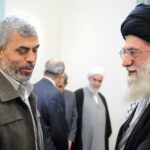International Politics
Islamism Is Not Iran: An Evening With Crown Prince Reza Pahlavi
The first thing I noticed about the crown prince of Iran is how much he looks like his father, the late shah of Iran. The second is the intense devotion of his followers. When the man took the stage at an event hosted by Tafsik at the Toronto Pavilion on May 26 after several other speakers, a deafening, minutes-long ovation shook the room, accompanied by the waving flag of Imperial Iran.
Reza Pahlavi is the eldest son of Mohammed Reza Pahlavi, who reigned for 37 years as the last shah of Iran before being overthrown during the Islamic Revolution of 1979. Pahlavi was born in Tehran in 1960, named crown prince at his father’s coronation in 1967, and in 1978 headed to the United States for jet fighter training at Reese Air Force Base in Lubbock, Texas. He never returned. The royal family fled Iran in January 1979 as discontent with the shah’s “White Revolution” exploded into mass protests. The shah’s departure marked the end of over 2,500 years of monarchical rule.
On February 1, Ayatollah Ruhollah Khomeini returned to Iran after 14 years in exile. His chartered flight from Paris to Tehran, accompanied by Western journalists in part for his own protection, is perhaps second only in historical significance to Lenin’s sealed train journey from Switzerland to Russia in 1917. On April 1, 1979, the Islamic Republic of Iran was formally established following a referendum. The new regime transformed daily life in Iran with theocratic crackdowns and the Middle East with the funding of proxy armies like Hamas and Hezbollah and the spectre of nuclear war.
Only two members of the exiled Pahlavi dynasty have remained in the public eye: the shah’s widow Empress Farah Pahlavi, who divides her time between the United States and London, and Crown Prince Reza Pahlavi, who lives in Great Falls, Virginia. The two royals have become symbols of resistance to the Islamic Republic for the dissidents of the Iranian diaspora, and that devotion was on full display in Toronto.
Tafsik is the first Jewish organization to bring the crown prince to Canada because the Jewish and Iranian diasporas share a common enemy in the Islamic Republic. In 2023, Pahlavi visited Jerusalem—the first high-profile Iranian official to do so since the Revolution. Len Khodorkovsky, who interviewed Pahlavi after his speech, emphasized the connection, noting that Cyrus the Great had granted the Jews permission to rebuild the Temple; Pahlavi’s visit to the Western Wall, the last remaining section of the Second Temple, highlighted the profound and age-old connection between two ancient peoples. Pahlavi’s attendance at the opening event of Holocaust Remembrance Day at Yad Vashem was also a public rebuke to the Islamic regime’s venal Holocaust denial.
Reza Pahlavi’s struggle on behalf of Iran has evolved over time. When his father died in 1980, he declared himself the rightful successor to the Pahlavi throne. Throughout the 1980s, he was connected to anti-regime forces seeking the overthrow of the Islamic Republic and established a government in exile. In recent years, Pahlavi has emerged as an advocate for a democratic Iran, advocating voting rights for women, the protection of human rights, the enshrining of fundamental freedoms, and the separation of religion and state. His life’s goal, he often states, is simple: to assist Iran in a transition to freedom.
He was introduced in Toronto by a fiery Iranian named Sophia Namvarazad, who gave a beautiful and poignant speech capturing the longing of exiles who cannot return to the land that courses through their blood. It was a fierce and unapologetic oration in defense of Iran, the Pahlavi dynasty, and resistance to Islamic rule. “We are the children of Cyrus, and we do not sleep!” she declared to roars of approval. The Crown Prince, she said, is not a man, but a symbol. The Western cities of our postmodern age are filled with crownless royals and landless nobility; Reza Pahlavi, his followers made clear, is something else.
Pahlavi began by harking back to the shared history of the Jewish and Iranian peoples.
“It is a pleasure to be with you this evening to discuss a vision close to my heart, and one coming closer and closer to becoming reality, The Cyrus Accords,” Pahlavi said. “The name Cyrus reminds us of a deeper truth: that the relationship between the Iranian and Jewish peoples is not a matter of modern diplomacy or fleeting politics. It is rooted in history—and one that is ancient, proud, and unique. Over 2,500 years ago, it was Cyrus the Great, the Iranian king, who freed the Jewish people from captivity and allowed them to return to their homeland and rebuild their temple.”
The Iranian people, Pahlavi emphasized, bear no ill will towards the Jewish people. “Few nations in the world have such a shared story of ancient respect and modern solidarity,” he said to cheers. “And few peoples understand so well the cost of tyranny—and the value of freedom. Let me say this clearly: the Iranian people do not seek enmity with Israel or with any of our neighbors. The Iranian nation seeks peace—real, durable peace—with the region and with the world.” As multiple speakers throughout the evening noted, Iran’s democracy movement is suppressed, but strong—many have taken to social media to express their support for Israel and to condemn the genocidal intentions of the Islamic leadership.
Pahlavi left no doubt about what he advocates: Regime change. But he emphasized that he is not calling for military intervention. Instead, he is asking that the Islamic Republic be treated as the pariah state that it is. “You can help hasten that victory by standing with the people of Iran, or you can prolong our suffering by continuing to empower their oppressors,” he stated. “The single greatest gift the world can give the Iranian people right now is to stop helping the regime—stop legitimizing it, stop funding it, stop negotiating with it as if it were a normal government.”
READ THE REST OF THIS COLUMN AT THE EUROPEAN CONSERVATIVE








